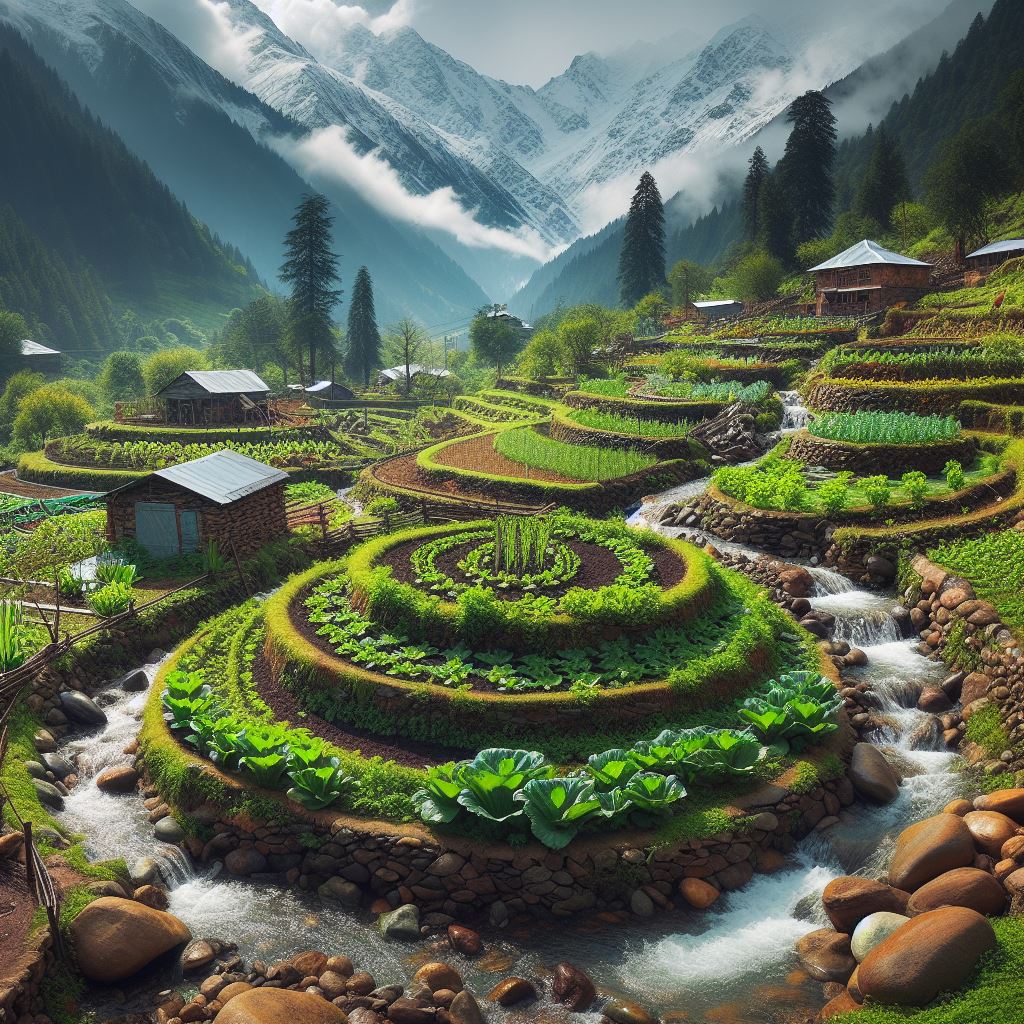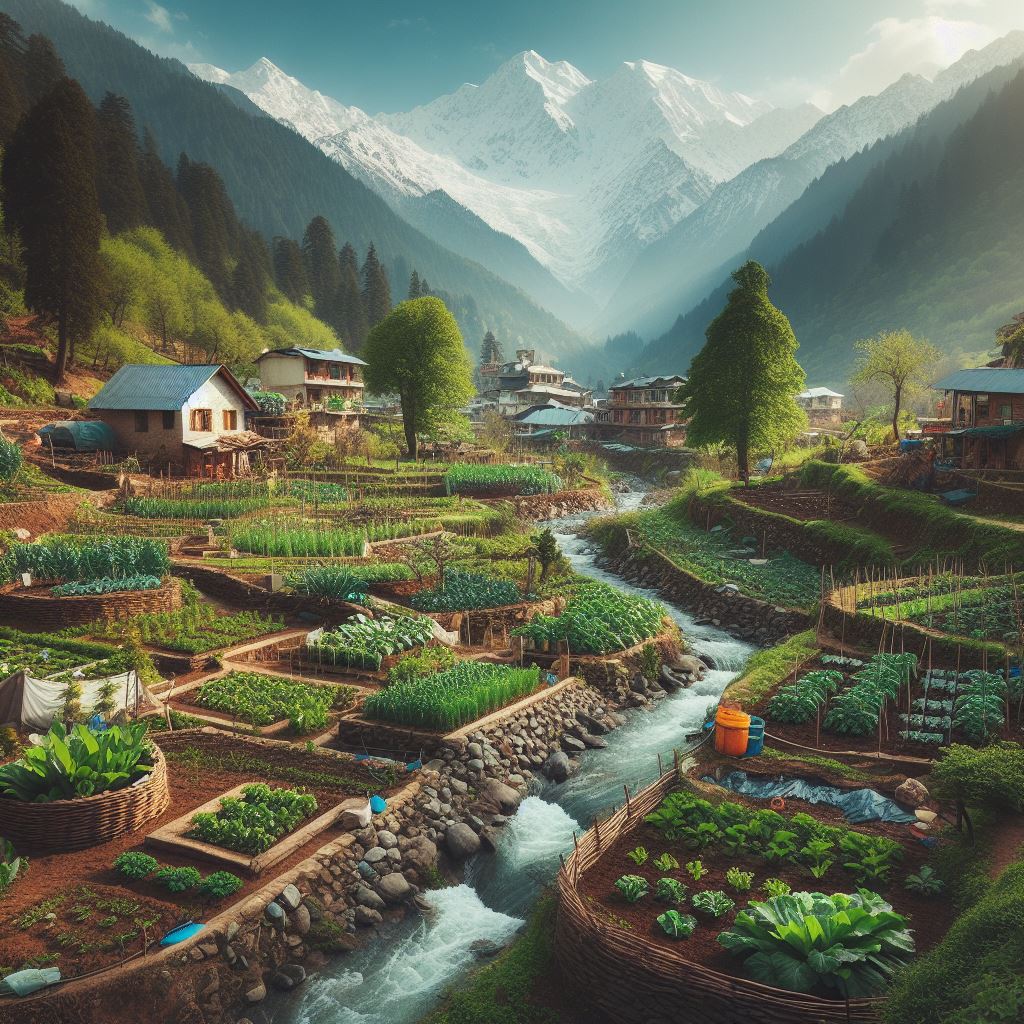Imagine waking up to the gentle chirping of birds, stepping outside into a landscape teeming with life, and plucking fresh, organic fruits and vegetables grown with your own hands. This isn’t just a permaculture dream—it’s the living, breathing reality of regenerative farming, right here in the Himalayas.
From Palampur’s misty slopes to its rich valleys, the future of farming lies not in chemical inputs, monocultures, or cash crop exports—but in reclaiming our relationship with the land, producing nutrient-dense food for local consumption, and reviving traditional, ecological wisdom.
🔁 Rethinking the Farm: From Exploitation to Regeneration
Modern agriculture often focuses on yield at the cost of soil health, biodiversity, and farmer well-being. But a shift is happening.
We’re seeing the rise of community-based, nature-aligned approaches like:
- Permaculture: Designing self-sustaining ecosystems that mimic nature.
- SPNF / ZBNF: Techniques that rely on natural inputs like Jeevamrit (cow dung, cow urine, jaggery, etc.), boosting soil health and reducing costs.
- Horticulture: Growing diverse fruit, medicinal, and flowering plants for better resilience and market returns.
- Holistic Collective Farming: Farmers pool land under an FPC (Farmer Producer Company) to farm together, share profits, use modern tools, and get expert support—without giving up land ownership.
These methods aren’t just good for the Earth—they’re practical, profitable, and empowering.

🧭 Begin With Your Land: Observation is Regeneration
Before digging the soil, listen to your land:
- Soil type: Is it clayey, sandy, or loamy? Each influences what and how you should grow.
- Sunlight: Some crops need full sun, others thrive in partial shade.
- Natural water flow: Observe rainfall patterns, runoff, and drainage. Harvest water through contour bunds or ponds.
- Existing vegetation: Native plants are allies—they reveal your land’s natural tendencies.
This awareness sets the foundation for a farm that regenerates life, income, and community.
🌳 Trees: The Backbone of Your Regenerative System
In the Himalayan foothills, trees are not optional—they are functional tools:
- Windbreaks: Plant Deodar, Himalayan Pine, or bamboo to protect soil and crops.
- Nitrogen fixers: Trees like Himalayan Alder or Sesbania enrich the soil naturally.
- Fruit trees: Apples, plums, apricots, pears, and cherries offer nutrition and income.
- Fodder & firewood: Species like Leucaena and Gliricidia serve multiple community needs.
Interplant trees with vegetables, pulses, and herbs to mimic a food forest—your own edible ecosystem.
🤝 Community Farming: Scale Without Losing Control
The Holistic Collective Farming Model offers an inspiring solution:
- Farmers retain land ownership, but pool land to farm together.
- Supported by a social entrepreneur or agri-expert, they gain access to capital, natural farming expertise, water, and better market linkages.
- Immediate daily wages + end-of-season profit shares make this model financially stable.
- Focus remains on local food production—millets, pulses, vegetables, fruits—for schools, mandis, local communities, not just far-off cities.
This reduces risk, increases income, and builds climate resilience—especially important in hilly terrains like Himachal.
🔄 Regeneration is a Cycle, Not a Shortcut
Whether you’re planting an apple tree, setting up a compost pit, or restoring native grassland—patience is your greatest tool.
Start with one acre. Build a food forest. Practice SPNF or ZBNF. Join a local FPO. Collaborate with other farmers. Observe. Adapt. Teach.
You’re not just a farmer—you’re a healer of the land.
❓ FAQs for Himalayan Farmers & Regenerative Agriculture Readers
- Is permaculture suitable for sloped land like in Palampur?
Yes! In fact, natural water harvesting techniques work better on slopes. - What is the difference between SPNF and ZBNF?
Both rely on zero synthetic chemicals. SPNF is a broader term coined by Subhash Palekar; ZBNF follows similar principles focusing on zero budget natural inputs. - Do I need to stop growing wheat and rice to do permaculture?
Not necessarily. You can integrate cereals with legumes, vegetables, and perennials using crop rotation and companion planting. - Can I join a collective farming model without giving up my land rights?
Absolutely. The Holistic Collective Farming Model ensures your ownership remains intact. You farm together, profit together—but keep your land title. - What crops work best under natural farming in Himachal?
Turmeric, ginger, local rajma, barley, buckwheat, and Himalayan herbs like tulsi, ashwagandha, and lemongrass. - Is regenerative farming profitable?
Yes—with lower input costs, better soil health, and local demand, many farmers earn more than in conventional models. - How do I start composting naturally?
Start with a simple pit using cow dung, kitchen waste, dry leaves, and jaggery. Mix weekly; in 40-60 days you get rich compost. - Can I grow fruit trees and vegetables together?
Yes, it’s called polyculture or agroforestry. It improves biodiversity, resilience, and income. - How can I sell my produce locally without middlemen?
Join or start an FPO, sell through weekly haats, local Kirana stores, or even supply to schools and cafes nearby. - I’m a small farmer. Can I still do this?
100%. Even 1/2 acre is enough to start. Many small farmers in Himachal are now turning to food forests and local markets. - Where can I learn more about natural farming?
Visit SPNF Himachal offices, Krishi Vigyan Kendras (KVKs), or join hands with social entrepreneurs working in your district. - Will this help the environment?
Definitely. Natural farming increases carbon sequestration, improves water retention, and restores biodiversity—vital for Himalayan ecology.
